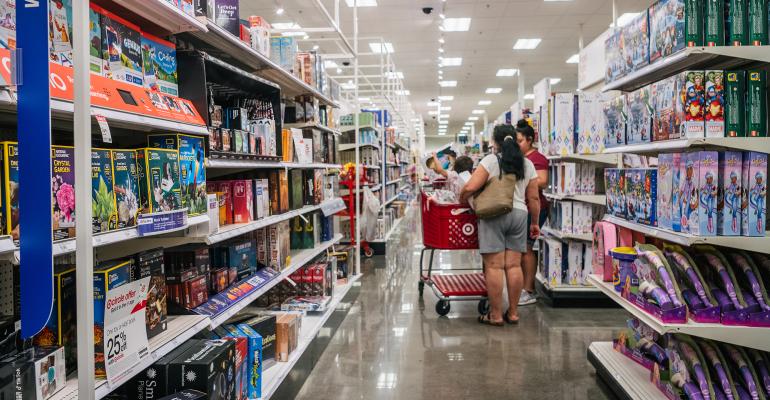(Bloomberg) -- Jude Snair knows retail. She works in the portrait department of a JCPenney at the Newport Centre mall in New Jersey. But with or without an employee discount, the 20-year-old said she was mostly avoiding holiday shopping this year.
“It’s looking more that people this year will be receiving homemade things,” Snair said as she filled out appointment sheets. She planned to cut her gift spending by more than half and vows to avoid Amazon.com, her main destination last year. “Do I even have the extra money to get stuff for people?”
It’s easy to understand her caution: The highest inflation in four decades is lashing consumers and pushing up prices for all of life’s necessities, not to mention the extras. Rising interest rates are pummeling the housing market, and war, extreme weather and extreme politics — not exactly the stuff of holiday spirit — are dimming the economic mood.
For the businesses that serve those skittish consumers, that means bracing for a slowdown next year that’s already threatening Wall Street jobs and inspiring warnings on earnings calls. The consumer pullback poses a particular existential threat for the retailers in the deepest financial trouble. More than $21 billion of bonds and loans tied to the industry trade at distressed levels, including debt for chain stores like Bed Bath & Beyond Inc. and Party City Holdco.
The National Retail Federation had predicted a sales increase of 6% to 8% this holiday season but has seen lower-income consumers pull back. That’s becoming evident in recent earnings reports from even some of the more resilient retailers, including Target Corp., which last month said third-quarter sales of discretionary items such as toys lagged and that it’s expecting a decline in fourth-quarter comparable-store sales as shoppers trim spending.
Inventory problems are adding to the stress. Retailers are still trying to offload piles of unsold goods after the pandemic delayed deliveries — with limited success. The buildup has even prompted sellers to tell suppliers to stop sending merchandise.
Still, problems with inventory show signs of easing. Nike Inc., for example, said that while its inventory for the quarter ended Nov. 30 jumped 43% from a year earlier, that was a slight improvement from the previous quarter’s 44% increase. Company executives said the number is inflated by abnormally low levels a year ago during pandemic disruptions.
Less Inclined
But Bloomberg Intelligence analyst Mike Campellone said extra goods will continue to confound merchants. “As the financial health of the US consumer weakens and shoppers become increasingly more price sensitive, excess inventory will remain a risk to sales and profitability,” he said.
Certain consumer categories will feel more of the impact from a slowdown. Apparel, especially casual clothing, is one of the nice-to-have-but-not-needed group of goods like home decor and electronics that are getting hit particularly hard, Campellone said. Sales of those items soared during the pandemic lockdowns, meaning even less-cautious consumers will be less inclined to spend on them now.
November, traditionally the beginning of the holiday sales frenzy, was disappointing even with retailers dangling big discounts, according to Bloomberg Intelligence senior analysts Poonam Goyal and Abigail Gilmartin. Same-store sales — a key gauge of performance — fell 2.8% overall, and apparel sales dropped 6.1%. Clothing retailers need a “December to remember,” they said.
And if retailers need to borrow to get through the lean times, it will cost them more. The Federal Reserve says it will remain aggressive about reining in inflation even after its latest half-percentage-point interest-rate hike.
Campellone says credit metrics of both high-grade and high-yield retailers “will continue to face pressure” in the first half of next year. The retail sector already has one of the highest proportions of distressed debt at 13.6%, according to S&P Global Ratings.
Next year could also bring an uptick in both individual and company bankruptcies. Far fewer consumers filed for bankruptcy the last two years than expected based on employment statistics, according to Gregg Morin of data provider Epiq Bankruptcy.
Tapped Out
From 2006-2019, there was a close relationship between the number of consumer cases and the unemployment rate, he said. With unemployment at 3.7%, there should be about 50,000 to 60,000 bankruptcy cases filed every month, Morin said. The last two years, there have only been about 30,000 a month. Next year, the historic trend is likely to return, which means twice as many consumers are likely to file for bankruptcy, especially if unemployment rises, Morin said.
This year, business filings are on track to equal, or fall below last year’s historic low. In 2021, about 3,700 Chapter 11 cases were filed, the lowest in at least 10 years, according to Epiq Bankruptcy. Through November this year, about 3,500 cases have been filed.
Not everyone is pessimistic. Yes, there will be a slowdown, but “the possibility of a soft landing is certainly looking better,” said Jennifer Lee, senior economist at BMO Capital Markets, with a continued strong job market, rising wages and savings.
Still, the slowdown was evident at Newport Centre in Jersey City on a weekday afternoon in mid-December. The mall wasn’t busy, and shoppers who spoke with Bloomberg said they were easing holiday spending this year.
Snair, the JCPenney worker, says she’ll follow a new rule next year, asking herself: “Do I really need it tomorrow? Can I do without it? And what substitutions can I make in place?”
© 2022 Bloomberg L.P.




